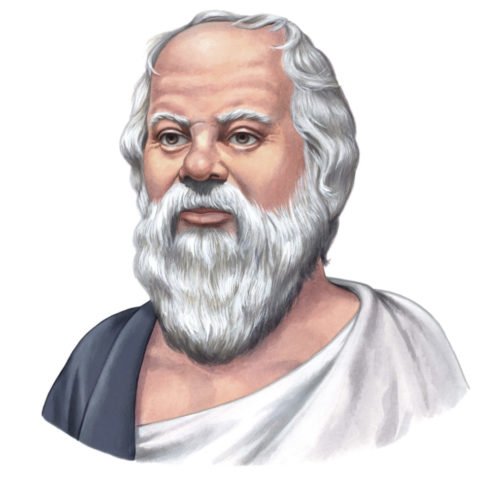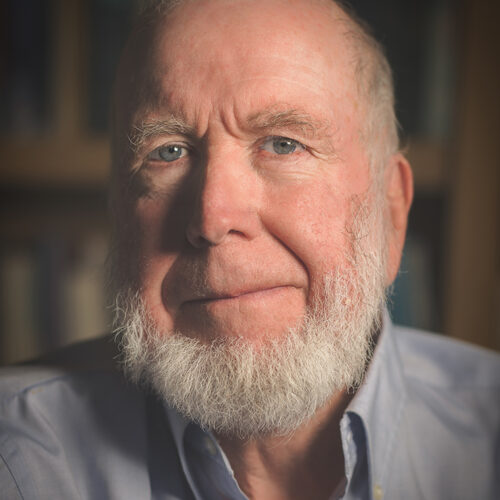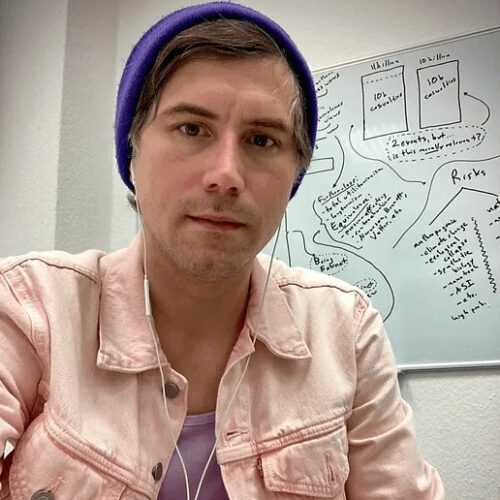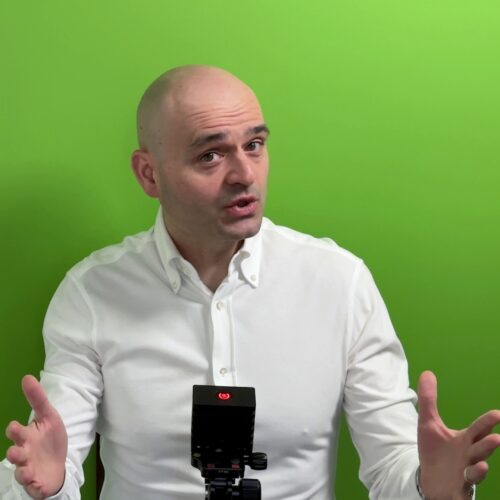Nikola Danaylov: Technology Reveals Who We Are, Not The Future
Podcast: Play in new window | Download | Embed
Subscribe: RSS
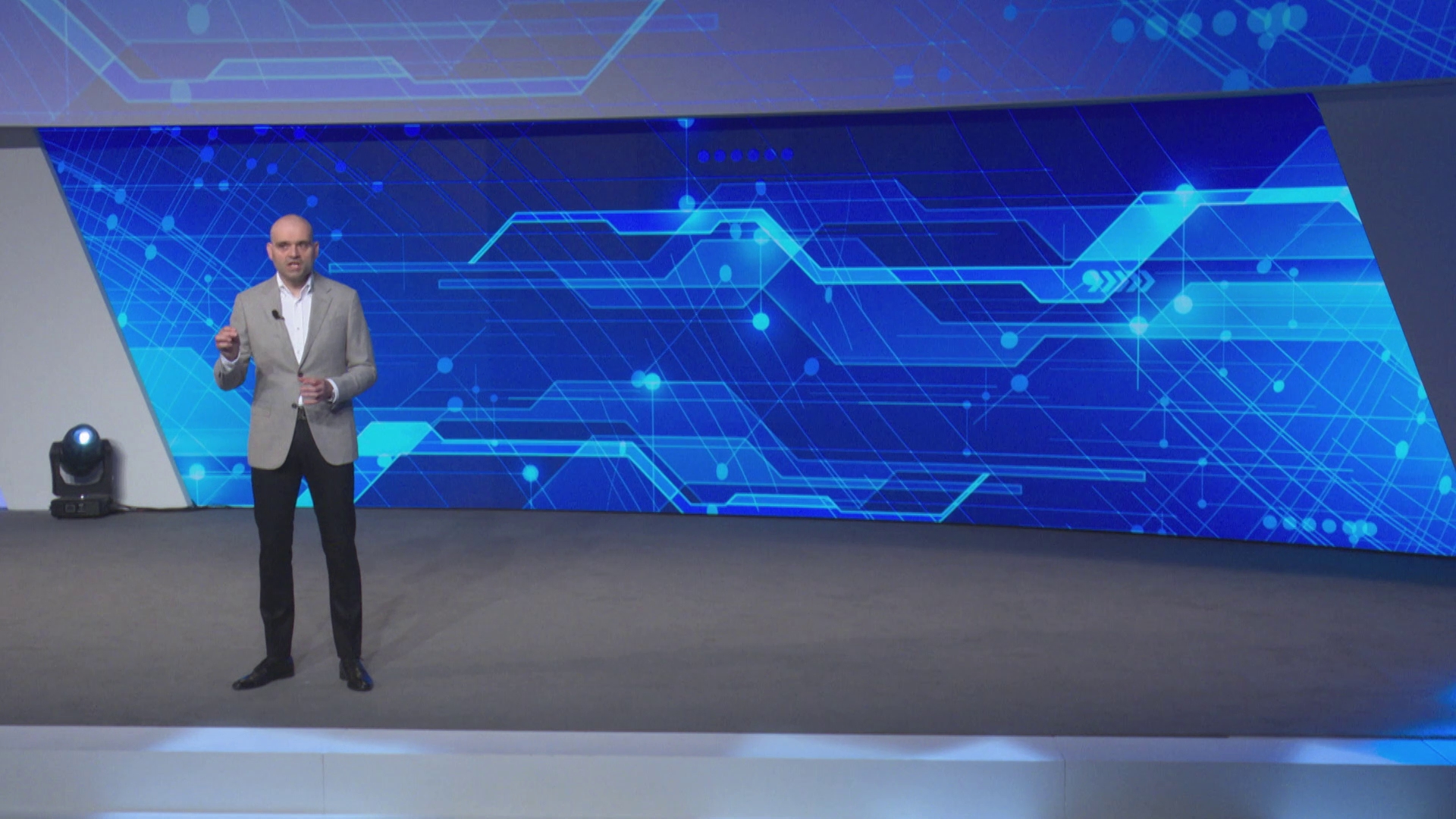 I recorded this virtual keynote for a corporate client about 10 days ago and decided to share it publicly. Hope you enjoy it 😉
I recorded this virtual keynote for a corporate client about 10 days ago and decided to share it publicly. Hope you enjoy it 😉
Technology is a Mirror, Not a Crystal Ball; It Reveals Who We Are, Not the Future
The 1st atomic bomb was nicknamed “gadget.”
Does this say something about who we are? Or does it say something about the nature of technology and the power to do good or evil?
Today we live in a universe of ever-more-powerful gadgets and humanity has never wielded more technological power because we live in the most scientifically advanced century in the history of our civilization. The paradox, however, is that ours is also the most dangerous century not only for countless other species going extinct but also for our own existence.
But how can that be? Isn’t technology good both for us and the world in general? And, most importantly, what can we do about this? Those are the questions I want to focus on today.
But I want to begin by sharing a personal story.
In 2016, my wife Julie and I took a road trip through California. Needless to say, Los Angeles and San Francisco were among our points of interest. Now, if you were going by car as we were, chances are that the very first thing you will see upon entering LA is those makeshift camps of tens of thousands of homeless Americans.
Well, 2 years before our trip, Peter Diamandis published his best-seller “Abundance” and told us that the future is better than we think. In it, Diamandis claimed that we can solve all of humanity’s grand challenges with enough capital, technology, and “the right people” – whom Peter titled the new Technophilantropists. And, yet, there we were, in his hometown, in the one place in the world with probably the highest concentration of all of the above, and we witnessed shocking poverty, high rates of crime and homelessness, severe drought, environmental destruction, and crumbling infrastructure.
I got so shocked that I decided to do some research. Only to get even more shocked in discovering that if you calculate the cost of living the “Golden State” of California, is, in fact, America’s poorest, because perhaps 1 out of 4 live at or below the poverty line. So while California has the 5th largest economy in the world and the largest in the US, according to McKinsey’s, it ranks 46th among the states for opportunity, 43rd for fiscal stability, and dead last for quality of life.
This paradoxical situation raises many important questions. For example: How is it that poorer countries such as Canada, which have less access to advanced technology and much fewer billionaires, somehow end up having a happier, healthier, and longer-living population, free health care, lower crime rates, and lower degree of homelessness?
Peter claims his 3 requirements for abundance will help us solve humanity’s grand challenges but the current COVID19 challenge provides more shocking evidence against his claim. Because the United States has 2 ½ times the Canadian death rate.
And this leads us to the 3 most popular myths about technology:
The 1st myth is the myth of Tech Utopia or what Diamandis calls Abundance. That the future is better than we think.
We already saw that in California, abundance is a myth. And I have spoken in the past about how tech startups like Singularity University create scarcity to sell abundance while charging an arm and a leg. And how they pretend to be solving humanity’s grand challenges. Take Facebook. Facebook is not solving humanity’s grand challenges. All it does is micro-targeting of ads to sell you things. And so do Google, YouTube, Twitter, Instagram, Amazon, and most others. All in all, if you think of it, despite their noble rhetoric there is very little saving the world and a whole lot of selling going on. This is why California is the disaster that it is today.
The 2nd myth is the myth of the new techno philanthropists – a few entrepreneurial nerds who will save the world by technological revolution while making trillions of dollars. But this revolution is not your grandfather’s revolution. Because this revolution is market-friendly. This revolution is one that Venture Capitalists can invest in. This revolution is lead from the top, not from the bottom. This revolution is for-profit and registered in Northern Ireland, Luxembourg, or some other tax haven so that this revolution pays no taxes. And its greatest accomplishment so far is translating old-school consumerism into the digital realm.
But, of course, a revolution that merely replaces those on top is not a revolution at all – it’s a coup. Because there is no paradigm change. Thus, Silicon Valley gave us not only fake news but also fake revolution, fake change, fake friends, fake saving the world, fake ethics, fake privacy, fake freedom, and, as we can see in the streets of LA and San Fran – fake abundance and fake techno philanthropists.
The reality is that Big Tech is nothing more than a classic extractive industry. So if in the 20th century the biggest companies were mining fossil fuels, today the biggest companies are mining data. And just like mining companies devastated our natural environment, today, Big Tech is devastating our social environment. Just like in the 20 century terrible crimes were committed in the developing countries where we had colonialism and sometimes genocide. Today we have data colonialism and, in places like Myanmar, genocide powered by Facebook – with 10,000 dead and a million refugees. That’s why Amnesty International says that Facebook and Google are a threat to human rights. And, I say that the techno philanthropists are simply the new digital robber barons.
It used to be that biology was destiny. Today it may turn out that data is destiny. And, if it is indeed true that data is power, then absolute data about absolutely everyone, absolutely everything that we do, absolutely all of the time may turn out to be the absolute power. Because as Big Tech collects the data, as they classify, trade, and sell it, what they are selling is not mere data. What they are selling is us. They are selling our identity. They are selling our values, they are selling our hopes, they are selling our dreams, and they are selling our fears. They are selling our past. And they are selling our future. Ultimately, they are selling our power of choice and self-determination. Because they believe that they know what is best for us.
Elon Musk once said that whatever disseminates power enhances democracy, and whatever concentrates power undermines it. I say that this unparalleled concentration of power is pushing us towards neotechnocracy. Neotechnocracy where those who make the tech tell us what to see and not to see, what books to read, what movies to watch, what to buy, who to have as our friends, where to go to school, where to live, where to work, whom to marry, who to believe, who to vote for, when to feel happy or sad. Because they are creating the greatest brain-washing propaganda machine the world has ever seen. And we are becoming a panopticon society where personal choice, privacy, and freedom are so threatened that even our dreams and thoughts are not likely to remain safe or private forever.
The neotechnocrats believe that all problems, including those created by technology, can and will be solved by more and better technology. And that they are the smartest and best people to solve them, while naturally making trillions of dollars. But creating a problem does not automatically create competence to solve the problem.
And so we get to the 3rd or perhaps the most popular and maybe even the most dangerous myth:
the myth that Technology allows us to see the future.
“Come and see this amazing new technology,” we often hear, “And you will see the future.”
I call this “the Crystal Ball” myth because I grew up with the witches and wizards’ fairy tales where magic crystal balls gave them the ability to see the future.
To evaluate the crystal ball metaphor, we have to first understand the etymology of the word technology – what it means and stands for, or at least what it used to mean and stand for. Then we can judge whether the etymological meaning of the word supports the above metaphor or some alternatives that I will propose.
The word technology comes from two Greek words – techne and logos. Techne means art, skill, craft, or the way, manner, or means by which a thing is gained. Logos means word, the utterance by which inward thought is expressed, a saying, or an expression. So, technology means words or discourse or a conversation about the way things are gained. In other words, technology is merely “how” we do things and not “what” we want or “why” we do them. Because it is not an end-in-itself. Instead, technology is merely a means-to-an-end, a tool.
That is why I want to propose a better metaphor: technology is a magnifying mirror. It doesn’t show us the future but merely reflects the present and, more importantly, it reflects who we are.
Technology is a mirror because it reflects the engineers, designers, entrepreneurs, and users who create and use it. But it is also a mirror to humanity in general and our collective dreams, our hopes and fears, our knowledge and our ignorance, our privileges and our responsibilities, our strengths, and our weaknesses, our good, and our evil. But it is not a usual kind of mirror because technology magnifies and amplifies things, and hence it brings its own biases. Thus it always has unforeseen consequences. And the critical point here is that technology reflects our essence. So, in a way, the story of technology is the story of humanity. [Just like the story of humanity is often told as the story of technology – e.g., the claim that we are a “tool-maker.”]
Now, why do I claim that the crystal ball metaphor is dangerous?
The result of believing it is that most tech conversations are techno-deterministic and focus exclusively on fixing the technology while ignoring the fact that it isn’t produced in a vacuum. That it mirrors our political, social, evolutionary, and cognitive biases. In other words, to use my metaphor, focusing exclusively on fixing the technology is like looking into a mirror, not liking the image we see, and then trying to fix that by polishing the mirror. But we have it upside down. Instead of focusing on the technology, we might want to invest some time and resources on improving ourselves instead – i.e., who we are being, what we are doing, and why we are doing it in the first place.
I will go as far as claiming that one of the keys to our future is keeping the right balance between exponential technology and humanity. So humanity must become exponential too. Not in the narrow technical sense. But in a broader philosophical sense with respect to wisdom, ethics, compassion, and strength of character in the face of ever-growing technological power and temptations.
Therefore, what I’m proposing is that, at the end of the day, it is not about technology. It is about us and what we do. Because, one way or another, it is not a shift in technology we are living through; it is a shift in humanity.
So we can have the best possible how, but if we mess up our why or what, we will end up doing more damage than good. That is why technology is not enough. It is necessary, but it is not sufficient.
And there are many historical examples of how better technology did not make our lives better but worse. For instance, historian Yuval Harari called the Agrarian Revolution “history’s greatest fraud.” [Because in every way measurable – i.e., health, longevity, work hours per week, nutrition, infant mortality, etc., we were better off as hunter-gatherers. The Renaissance and the Industrial Revolution were also “frauds” in the sense that most contemporaries ended up worse off than they previously were. So, the story of progress, that technology is inherently good or that it always gives us freedom is incomplete and one-sided. And, if we are not careful, we are running the risk that our current technological revolution may turn out to be our epoch’s greatest fraud.
You can see that nowhere better than in Silicon Valley in general and Facebook in particular.
Take Silicon Valley. The way that many startups begin is usually by some new technology that they don’t know how to use and apply. In other words, they start with a “how.” For example, in the case of Google, it was a new search engine algorithm called Page rank or, in the case of Facebook, a sexist platform that allowed nerdy freshmen to rank the profile pictures of their female colleagues. Then, usually after some angel or venture investment, startups “pivot” to monetize” their unique “how.” But this is like putting the cart in front of the horse where the cart is “how” we do something and the horse is “why” we have a cart in the first place. And when we have the cart driving the horse, in other words, when we have people serving technology rather than technology serving people, then we get the kinds of results that we’ve got.
Take Facebook, for example. After pivoting from female student pictures to a student social platform, Facebook became magic. Many tech gurus like Peter Thiel said that Facebook is the future. It was a magic utopia where everyone could socialize with everyone else everywhere around the world, easily and for free. But then it became manic because we realized how addictive it is, how it feeds our worst impulses, how it makes us both ADD and obsessive-compulsive. Eventually, with the Cambridge Analytica revelations and the Myanmar genocide, we realized it has become monstrous. And it is not hard to see that most technologies since the industrial revolution either already follow a similar path from magic through manic to monstrous or are in danger of doing that. And that is, of course, because we, humanity, are magic, manic and monstrous. And Technology reflects us. Examples abound, but I can’t think of anything better than plastic.
You see, in the early 20th-century plastic was literally marketed as the magic material. Because you could do almost anything out of plastic but cheaper, faster, and easier. And so we quickly became manic obsessive and did build nearly everything out of it. Today, it is not hard to see that we are neck-deep in the monstrous stage because whole areas of our oceans contain more plastic pieces than fish. And, to give you a tiny example of just how bad it has become, check this out:
we now produce 1,000,000 plastic water bottles per minute on our planet.
What is worse is that, at best, only 9% ever get recycled. The other 910,000 plastic bottles per minute end up in the environment. And, of course, water bottles are but a tiny fraction of the total plastic production on our planet. So it is no surprise that we are drowning in this originally magic, then manic, and now monstrous technology.
So, the question then is: “Why would AI be any different?!”
There are many cases where we can see that AI risks going from magic to manic to monstrous, where we can see that AI does not help us discover the future but reveals who we are.
Take Tay. Tay was an AI chatbot created by Microsoft in 2016 that was specifically designed for Twitter and launched to a fanfare of promises, including the claim about seeing the future. Well, in 12 hours, Tay became racist, xenophobic, misogynistic, and sexist. In 16 hours, Microsoft had to shut it down.
So, what I’m suggesting here is that it is not necessarily about the AI. It is perhaps most about the I. And the I, of course, stands for intelligence. The I stands for us. We are the I. We are the cake. The artificial part is just the icing on the cake. So all of those who are warning about the existential threat posed by AI is either misunderstanding or, worse, misrepresenting the issue. Because the dangers come not from the artificial part but from the intelligence part. That is why the AI doomsayers remind me of the African proverb which goes like this:
“The sheep will spend its entire life fearing the wolf, only to be eaten by the shepherd.”
That is why Frank Herbert started his 1965 classic novel Dune with a story about the people who turned their thinking over to machines in the hope that this would set them free only to find themselves enslaved by other people with machines.
Look around the world today, and you will see that humanity is the greatest threat to humanity, not some alien or artificial intelligence. We have met the enemy, and it is us. Because humanity is the greatest threat to all life on our planet. We are the terminators for we are bringing about the 6th extinction. That is why Yuval Harari calls homo sapiens a mass-murdering species.
This is also why techno-solutionism is so dangerous. Because, as Dr. Matthew Cole says:
“Every time that technology tries to stand in for ethics, we do ourselves a disservice, […] we deny ourselves the opportunity for growth.”
Now, many will argue that technology does help us solve problems. I do not deny that. I myself absolutely love technology. But I do not worship it. All I’m saying is that technology, while necessary, is not sufficient. Especially when it comes to the major issues, we are facing today.
Take global warming. We know the science – it is pretty uncontroversial and conclusive. And we do have most, maybe even all, the technology required to move beyond fossil fuels and meat consumption – 2 of the most damaging factors to our environment and our own health. And yet, we are not taking sufficient action. We’re hoping that someone else will give up driving cars or eating meat three times per day. Or that artificial intelligence will come and solve not only Climate Change but all of our problems.
In other words, our civilization is like an alcoholic with a failing liver. And technology offers us the hope that we can 3d bio-print a new liver just in time while failing to acknowledge our own self-destructive habits and our own responsibility, thereby failing to address the actual problem rather than the symptoms.
We are destroying ourselves and our planet, while putting our hopes and fears in things like God, or AI, capitalism, science, and technology:
Our techno-deity, aka “science and technology,” will save us.
Or the wrath of God-like super-intelligent AI will destroy us.
Or the invisible hand of the free market will raise all boats and bring about the best equilibrium.
And we keep telling ourselves that convenient story. That convenient lie. So that we can keep avoiding an inconvenient truth:
That humanity is the greatest threat and hope for humanity. Not some omnipresent, all-knowing, almighty force residing outside of us.
That we may not be Gods yet but we are in charge already.
It is us who are the most powerful force on our planet. We are the real destroyers and creators. We ought to take both the credit and the blame for where we are today and the problems we have. It is us who are driving the train towards the trainwreck. Therefore, only we can move our foot off the gas pedal and hit the brakes to save ourselves.
We have to recognize that on the upside, our ever more powerful technology has clearly proven that the sky is not the limit. That everything is possible. That we can defeat poverty, infectious disease, blindness, cancer, aging, even death. We can have near-infinite access to solar energy that would provide us with unimaginable material abundance and comfort. In other words, for the first time in human history, we have the technological means to build the closest thing to utopia. And the fact that humanity was able to design and produce a COVID19 vaccine in record-breaking 10 months is but one of endless positive technological examples.
But we also have to recognize that technology is not enough. And so the opposite option: a complete dystopia with a global pandemic, climate collapse, failed states, civilization collapse and maybe even nuclear or AI Gigawar and extinction of the entire human race are also possible. Because technology is a double-edged sword.
So far I’ve mostly given you examples of how humanity is the problem. But the good news is that if we are the problem that means that humanity can also be the solution. We are in a position to influence the future. We have the power and the responsibility to make a positive contribution. So we should not merely wait and let the future happen to us but instead, make it happen. In other words, we can drive change instead of being driven by it.
And, yes, we have to acknowledge that we are in a civilization-wide crisis. But that is not and should not be a fact that makes us simply fearful, passive, and depressed.
Because, to quote Frank Herbert again, “fear is the mind-killer.”
You see the Chinese word for crisis (weiji) consists of two characters: one signifying danger and another, which according to some interpretations, is signifying opportunity. The English word that we use comes from the ancient Greek word “Krisis” meaning to decide.
So the moral here is that we should not simply fear a crisis – due to its inherent dangers, but we should also embrace and try to make the best of it – due to the unique opportunity that is hidden within. And that is something we often forget – that a crisis is a terrible thing to waste. Because a crisis is a time to decide, to make a choice, and to commit. An opportunity to reinvent ourselves for the better.
This profound realization – that there is always more than a single tragic path in front of us, can provide just enough optimism that, in the end, makes all the difference to those who need it most. Because desperation is a luxury we can’t afford, and hope is a duty we must fulfill.
It is also why Winston Churchill noted that “The optimist sees opportunity in every danger; the pessimist sees danger in every opportunity.” But my job here today is not to be an optimist. Or a pessimist. My job is to be a realist and to lay out the full horizon of both the dangers and the opportunities we are facing today. So the key here is that the obstacle is the way. Yes, sometimes it seems that the world is all going to hell. But great blessings lie ahead for those who know the secret to finding opportunity within each crisis.
So the first step is honesty. Because it takes brutal honesty to recognize the depth of the hole we have dug ourselves into. Honesty that it was us who dug the hole. And honesty that we cannot rely on a divine or technological miracle to save us.
The 2nd step is to look for hope in the fact that there is hardly anything absolutely unique in our predicament. That many other people, organizations, corporations, and civilizations have failed and succeeded in similar situations. So we should seek the positive role models – to emulate them, and the negative ones – to learn from their mistakes.
So let’s look at 2 examples of corporate response to a crisis. The first one is Kodak and I suspect that many of you may be familiar with it. However, I still want to share it because it sets the context for the success of one of its major competitors and gives us a strategy about what we can do – personally – as employees, but also collectively, as corporations, nations, and even as a civilization.
Plus, I do have a direct personal connection to Kodak because half of my wife’s family is from Rochester, New York, which used to be known as “Kodak City.” In 1996, Kodak had a 28-billion-dollar market cap and almost 100,000 employees. The company looked invincible. But the future will find us all. And it doesn’t matter if you are a billion-dollar company, a student, manager, or salesperson in Canada, or a Masai warrior in Africa. The real question is will we find the future?
Back in 1975, Kodak had invented the first digital camera. So, in a way, they had already found the future. But the problem was that Kodak wasn’t interested in the future because Kodak really loved the present. Kodak was in the paper and chemicals business, it did not pay them to disrupt their own business model, so they didn’t embrace digital photography. And in 2012 Kodak went bankrupt.
This is what disruptive change looks like. It means that after the meteorite strike, dinosaurs die out – no matter how big and strong they are, and a new species will rise to dominate the environment. This is where many of the dangers and opportunities we face today are. And some of us can see the meteorites coming. The question we need to answer is: are we going to see the meteorites as dangers or opportunities?
Because our greatest strengths are also our greatest weaknesses. So let me ask you this: Is your business or your professional career structured around providing THE answer, or THE solution to a problem? Because, in the age of Google, answers are free, but good questions can be priceless. Because the better the question, the better the answer. So the value creation is shifting more and more towards the questions.
Because it turns out that answers have a limited lifespan, so holding too tight to an answer can be at least very costly, if not outright deadly. That is why IBM was best positioned to profit from the personal computer revolution, but they missed it. Instead, Apple, Microsoft and Dell became giants. Later, they were best positioned to exploit the search engine revolution, but they missed it. Instead, Google became a giant. Google was best positioned for the social networking revolution but missed it. Instead, Facebook and LinkedIn became giants. Blockbuster was best positioned to benefit from the video streaming revolution but they missed it and YouTube and NetFlix became giants. German and Japanese carmakers were best positioned for the electric car revolution, but they nearly missed it. Tesla is now emerging as the leader, though it is still too early to say how things will shape up there.
So, ask yourself this question: What am I missing? What is the question that I should be asking? That is where the next threat or breakthrough opportunity is hiding.
Let’s go back to Kodak. As I said before, in 1996 Kodak was 28 billion dollar company with 100,000 employees and 90% market dominance. Its main competitor was Fuji and Fuji was about 10 times smaller than Kodak. The most interesting thing however is that when Kodak filed for bankruptcy in 2012 at the same time Fuji was a healthy and growing 18 billion-dollar company. So what was the difference? Why did Kodak die and Fuji prosper if both of them were paper and chemicals companies facing the same crisis?
The short answer is because Kodak tried to change themselves and Fuji, in contrast, reinvented themselves completely.
You see, when in the early 2000s Kodak saw the emergence of digital photography they decided to become a digital image company. In other words, Kodak wanted to change from analog to digital. Fuji, on the other hand, saw that digital is not a mere change but a symptom of a radically new world. So, they concluded that change is not enough. This is why they decided to reinvent themselves completely and move in multiple and diverse new markets. So originally 70% of Fujifilm’s profits came from film. Today it is less than 0.5% and the vast majority of profits for Fujifilm come from pharmaceuticals, cosmetics, and healthcare.
It turns out that while photo film is nearly useless today the technology, the science, and the expertise behind it can be very, very lucrative, provided that you can find a proper application. So the product – film, like most contemporary products, has a very limited lifespan but the science and technology behind it can be utilized to make an entirely new business altogether. For example, during their decades of developing color film, Fujifilm has accumulated a library of 20,000 chemical compounds. Some of those compounds were used to preserve the film and protect it from fading. Well, it turns out that the same technology can be used in cosmetics to protect the skin from the sun and to help prevent sagging. Other compounds were applied in the production of LCD screens, computer storage devices, and printing hardware. In fact, just last month Fuji announced a new highly sensitive and accurate COVID19 test, which was created using its proprietary photo-developing silver amplification immunochromatography.
So the question is, what was Fuji’s secret to reinventing itself?
And it is the philosophy of kaizen.
I don’t know if you are familiar with KaiZen but, like crisis, the Japanese concept of KaiZen consists of two characters: Kai and Zen. Those who are familiar know that Kai means change and Zen means good. So KaiZen literally means “change good.” But that is just the start. And the really interesting etymological meaning comes if we dig a bit deeper.
It turns out, that each of those characters themselves also consists of two parts. Kai consists of “self” and “whipping”. So when you think of the word change think of someone whipping themselves. So I can’t beat you up to force you to change. And you can’t beat me up to force me to change. We each have to do it ourselves.
Now, the character for Zen consists of 2 parts: the top part designates a sheep, or a lamb, or a goat. And the bottom part stands for an altar. So, Zen is actually a lamb sacrificed on an altar. A sacrifice. That is what is most often translated as “good” because sacrifices are good for the Gods and good for the people who do them. So, putting it all together, the word KaiZen means to whip yourself and make a sacrifice. And that is change. And that is good. For we all need to take some punishment and make sacrifices to adapt to change and evolve if we want to thrive.
We live in an age of accelerating change and exponential technology. The riskiest thing we can do is to try to play it safe and stay the same. The safe thing now is to be different. To be a purple cow. To be remarkable. To take risks. To try what may not work. To not be afraid of failure.
So, the question is: Are you personally, your business, and our civilization, in general, going to be a Kodak or a Fuji?
Most importantly: Are we going to go extinct like the dinosaurs? Or, are we going to populate the universe, like Elon Musk is dreaming of?
Because my promise to you today is that the future will find us all, no matter where we are and what we do. But the question remains: Will we find the future?
You see, technology is pretty good at giving us what we want, but it is terrible at giving us what we need. It’s good at supplying information, even knowledge, but terrible at providing wisdom. It helps us live easier, more comfortable, and longer lives, but it does not tell us why we should live or what to do with our lives in the first place. Most importantly, technology does not make us happy. There is no app for happiness. In fact, during the current pandemic, we are using more tech than ever before, and we are more unhappy, more depressed, and more suicidal than ever before.
So, while AI may help us get whatever we wish, it is wisdom that helps us figure out what we should want [or not] in the first place. Intelligence can be useful only in that case. Because lacking the wisdom to know what we should and should not want but having the intelligence – be it artificial or biological, to get it is a path to self-destruction.
That is why all the significant existential challenges we face today – be it Climate Change, Environmental Destruction, Nuclear weapons, Soil Erosion, Species Extinction, Plastic, and Other Toxic Pollution, Ocean Acidification, even Pandemics, etc. are without exception the same problem playing itself out over and over again. Namely, humanity’s technological power is out-pacing our wisdom to control and use it in a productive, safe, non-destructive, and non-suicidal manner.
Clearly, more powerful technology, not accompanied by a proportional growth in our own wisdom to utilize it, will make the gap bigger and therefore the above problems worse, not better. Therefore the greatest project of our civilization is not AI. It is humanity. And so we don’t need a moonshot. We don’t even need an Earthshot. We need a shot of and for humanity. Because humanity is the greatest project of our civilization.
And that is why we must go back to the original meaning of the word technology. Technology is merely a tool, a means to an end, never an end in itself. It is useful as a crutch, but, as with all crutches, we can become slaves to its use unless we condition and develop our own strength.
It can, therefore, enable just as much as it can disable us. It therefore can destroy and enslave us just as much as it can liberate and save us. Therefore, while technology may be the path to our salvation or the path to our destruction, it will not be the reason as per why we end up there.
Because technology reveals who we are, not the future. And if we put garbage in, we are going to get garbage out. Only this time it’s exponential. The same applies to stupidity, prejudice, or evil. Therefore, we can’t fix technology unless we take both personal responsibility – as individuals, and collective responsibility – as corporations, organizations, nations, and even as a species. Because technology is a magnifying mirror, not a crystal ball.
So, to sum it up, what I’ve argued here today is simply this: Technology doesn’t create abundance on its own – but we can. It doesn’t create a philanthropist revolution – but we can. And it doesn’t help us see the future – no one can. But together we can build a future with dignity and respect for all sentient life. A future we’re all proud of. A future where our children will inherit a safer, greener, and freer world.
But to do all this we have to start before technology. We have to start with why. And the why is ethics.
The how, the technology, is only needed later.
Thank you!


